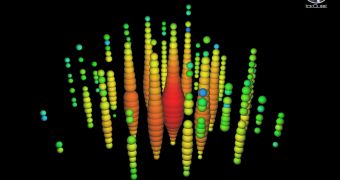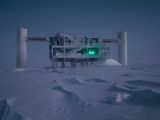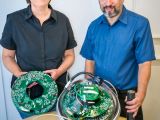The international collaboration of researchers managing the IceCube Neutrino Observatory at the Amundsen-Scott South Pole Station, in Antarctica, announces the discovery of 28 high-energy neutrinos produced by cosmic particle accelerators. This is the first time these particles are identified.
According to researchers, these particles are accelerated to 99.99 percent the speed of light in massive accelerators that develop around large objects in space. Swirls of magnetic fields around black holes and supernovae are widely considered responsible for creating extremely high-energy neutrinos.
Scientists with the US Department of Energy's (DOE) Lawrence Berkeley National Laboratory (Berkeley Lab), who are a part of the IceCube Collaboration, say that the cosmic particle accelerators can be 40 million times more powerful than the CERN Large Hadron Collider.
The discovery of the 28 neutrino events in the ices beneath Antarctica constitutes “the first solid evidence for astrophysical neutrinos from outside our solar system,” says Berkeley Lab and IceCube scientist, Spencer Klein. He adds that the detector array also discovered two of the most energetic neutrinos ever recorded. These particles have been called Bert and Earnie.
Neutrinos are elementary particles with zero electric charge, which are capable of passing through solid matter without interacting with it too much. Particle physicists estimate that trillions of neutrinos pass through us every second, but only one or two may leave signs of their passing, if that.
Regardless of the difficulties associated with finding neutrinos, University of Wisconsin-Madison (UWM) scientist Francis Halzen dedicated the last couple of decades to this purpose. He is the principal investigator of IceCube, and a distinguished professor of physics at UWM.
Halzen and his group also came up with the idea to create the Antarctic telescope out of ice, since this material is the perfect medium for detecting neutrinos. IceCube is basically a 1-kilometer (0.6-mile) cube of ice that is riddled with light detectors.
Whenever a neutrino interacts with the ice molecules, it gives off a small flash of light that is detected by these instruments. “It's the ultimate transparent medium. I don't think you can make in a lab a medium as transparent as ice,” Halzen explains, quoted by NPR.
Details of the discovery are published in the November 22 issue of the top journal Science. In the paper, the team explains that high-energy cosmic neutrinos are produced by high-energy events and objects in the Universe, including supernovae, black holes, active galactic nuclei, pulsars and so on.
Neutrinos produced in the Earth's atmosphere are relatively common, but high-energy neutrinos from the deep reaches of the Milky Way or beyond are more difficult to identify. These positive identifications could provide physicists with a new angle for studying the high-energy Cosmos.
All 28 detections were made during a study conducted between May 2010 and May 2012, by the 5,160 digital optical modules that permeate IceCube. The observatory was built with funds from the Division of Polar Programs and Division of Physics at the US National Science Foundation (NSF).
“The success of IceCube builds on the efforts of hundreds of people around the world. IceCube collaborators made it all happen – from the design and the deployment in a harsh environment, proving the feasibility of the concept, to data harvesting and physics analysis,” says IceCube spokesperson Olga Botner.
“All required concerted efforts that ultimately have led to the observations presented in this paper. Now the collaboration is addressing a further challenge: How to make IceCube a big contributor to astronomy,” adds the expert, who holds an appointment at the Uppsala University.
The IceCube Collaboration includes researchers from the United States, Germany, Sweden, Belgium, Switzerland, Japan, Canada, New Zealand, Australia and the United Kingdom. Around 250 physicists are involved with analyzing the data obtained from this observatory.

 14 DAY TRIAL //
14 DAY TRIAL // 

